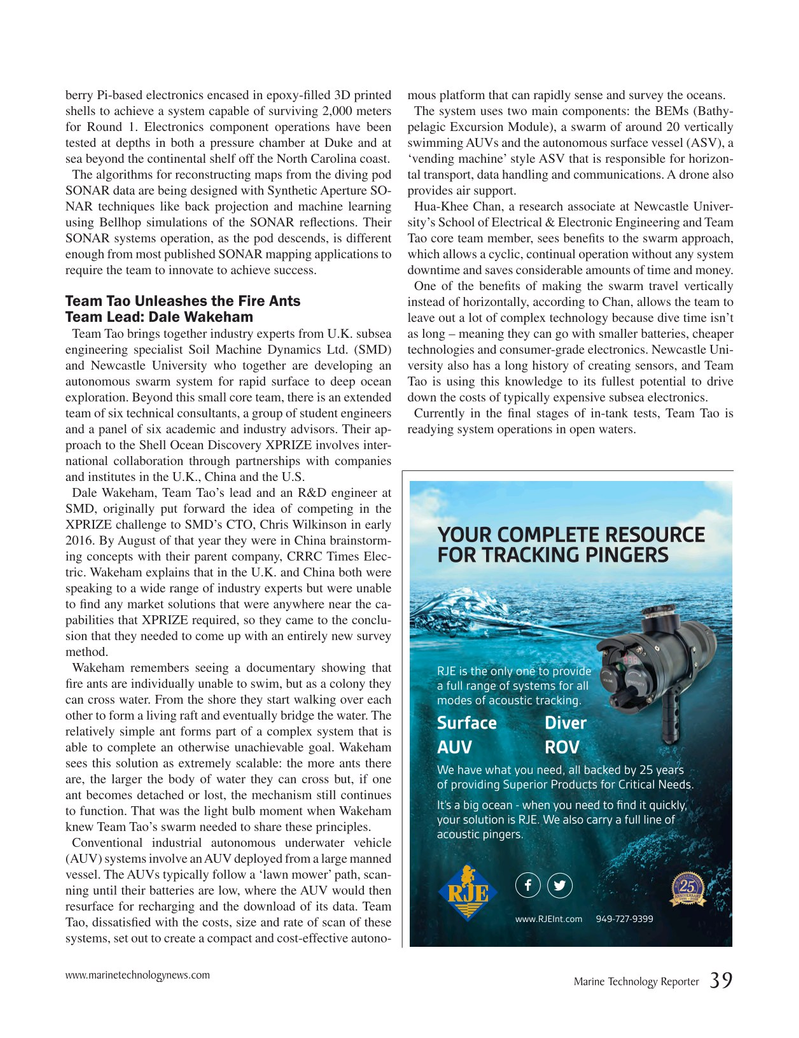
Page 39: of Marine Technology Magazine (September 2017)
Ocean Observation: Gliders, Buoys & Sub-Surface Networks
Read this page in Pdf, Flash or Html5 edition of September 2017 Marine Technology Magazine
berry Pi-based electronics encased in epoxy-? lled 3D printed mous platform that can rapidly sense and survey the oceans. shells to achieve a system capable of surviving 2,000 meters The system uses two main components: the BEMs (Bathy- for Round 1. Electronics component operations have been pelagic Excursion Module), a swarm of around 20 vertically tested at depths in both a pressure chamber at Duke and at swimming AUVs and the autonomous surface vessel (ASV), a sea beyond the continental shelf off the North Carolina coast. ‘vending machine’ style ASV that is responsible for horizon-
The algorithms for reconstructing maps from the diving pod tal transport, data handling and communications. A drone also
SONAR data are being designed with Synthetic Aperture SO- provides air support.
NAR techniques like back projection and machine learning Hua-Khee Chan, a research associate at Newcastle Univer- using Bellhop simulations of the SONAR re? ections. Their sity’s School of Electrical & Electronic Engineering and Team
SONAR systems operation, as the pod descends, is different Tao core team member, sees bene? ts to the swarm approach, enough from most published SONAR mapping applications to which allows a cyclic, continual operation without any system require the team to innovate to achieve success. downtime and saves considerable amounts of time and money.
One of the bene? ts of making the swarm travel vertically
Team Tao Unleashes the Fire Ants instead of horizontally, according to Chan, allows the team to
Team Lead: Dale Wakeham leave out a lot of complex technology because dive time isn’t
Team Tao brings together industry experts from U.K. subsea as long – meaning they can go with smaller batteries, cheaper engineering specialist Soil Machine Dynamics Ltd. (SMD) technologies and consumer-grade electronics. Newcastle Uni- and Newcastle University who together are developing an versity also has a long history of creating sensors, and Team autonomous swarm system for rapid surface to deep ocean Tao is using this knowledge to its fullest potential to drive exploration. Beyond this small core team, there is an extended down the costs of typically expensive subsea electronics.
team of six technical consultants, a group of student engineers Currently in the ? nal stages of in-tank tests, Team Tao is and a panel of six academic and industry advisors. Their ap- readying system operations in open waters.
proach to the Shell Ocean Discovery XPRIZE involves inter- national collaboration through partnerships with companies and institutes in the U.K., China and the U.S.
Dale Wakeham, Team Tao’s lead and an R&D engineer at
SMD, originally put forward the idea of competing in the
XPRIZE challenge to SMD’s CTO, Chris Wilkinson in early
YOUR COMPLETE RESOURCE 2016. By August of that year they were in China brainstorm- ing concepts with their parent company, CRRC Times Elec-
FOR TRACKING PINGERS tric. Wakeham explains that in the U.K. and China both were speaking to a wide range of industry experts but were unable to ? nd any market solutions that were anywhere near the ca- pabilities that XPRIZE required, so they came to the conclu- sion that they needed to come up with an entirely new survey method.
Wakeham remembers seeing a documentary showing that
RJE is the only one to provide ? re ants are individually unable to swim, but as a colony they a full range of systems for all can cross water. From the shore they start walking over each modes of acoustic tracking. other to form a living raft and eventually bridge the water. The
Surface Diver relatively simple ant forms part of a complex system that is able to complete an otherwise unachievable goal. Wakeham
AUV ROV sees this solution as extremely scalable: the more ants there
We have what you need, all backed by 25 years are, the larger the body of water they can cross but, if one of providing Superior Products for Critical Needs.
ant becomes detached or lost, the mechanism still continues
It’s a big ocean - when you need to ?nd it quickly, to function. That was the light bulb moment when Wakeham your solution is RJE. We also carry a full line of knew Team Tao’s swarm needed to share these principles.
acoustic pingers.
Conventional industrial autonomous underwater vehicle (AUV) systems involve an AUV deployed from a large manned vessel. The AUVs typically follow a ‘lawn mower’ path, scan- ning until their batteries are low, where the AUV would then resurface for recharging and the download of its data. Team www.RJEInt.com 949-727-9399
Tao, dissatis? ed with the costs, size and rate of scan of these systems, set out to create a compact and cost-effective autono- www.marinetechnologynews.com
Marine Technology Reporter 39
MTR #7 (34-49).indd 39 MTR #7 (34-49).indd 39 8/24/2017 9:22:54 AM8/24/2017 9:22:54 AM

 38
38

 40
40
